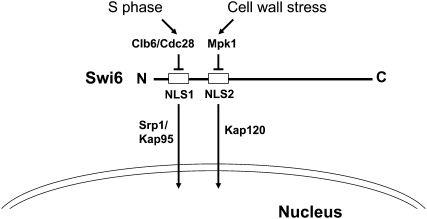Figure 2 .
The CWI signaling pathway. Signals are initiated at the plasma membrane (PM) through the cell-surface sensors Wsc1, -2, -3, Mid2, and Mtl1. The extracellular domains of these proteins are highly O-mannosylated. Together with PIP2, which recruits the Rom1/2 GEFs to the plasma membrane, the sensors stimulate nucleotide exchange on Rho1. Relative input of each sensor is indicated by the width of the arrows. Additional regulatory inputs from the Tus1 GEF and the Pkh1/2 protein kinases are indicated. The various effectors of Rho1 include the β-1,3-glucan synthase (GS), β-1,6-glucan synthase activity (not shown), formins (Bni1), Sec3, and the Pkc1-activated MAPK cascade. Mlp1 is a pseudokinase paralog of Mpk1 that contributes to the transcriptional program through a noncatalytic mechanism. Two transcription factors, Rlm1 and SBF (Swi4/Swi6), are activated by the pathway. Skn7 (dashed line) may also contribute to the CWI transcriptional program. (Inset) Thin-section electron micrograph of a Pkc1-depleted cell that has undergone cell lysis at its bud tip. Conditions were as described in Levin et al. (1994).

